
| Algorithm Specification |  |
The optical water type classification (OWT) tool is an adaptation of a spectral based optical pre-classification scheme (Moore et al., 2001) that calculates clusters from in-situ spectra. These spectra have been collected by different users from all over the world (University of New Hampshire and NASA's SeaBass in USA and CEDEX in Spain) and by partners and advisors of the EU- GLaSS and the ESA DUE CoastColour projects. The tool assigns the water type class that corresponds to the best match between the remotely sensed and the in situ spectrum. Moore et al. (2001, 2014) designed a fuzzy logic spectral classification scheme that was adapted for coastal waters and lakes. In situ hyperspectral data were used to characterize optically distinct water classes a priori. The aggregated data come from multiple sources and covers a wide range of concentrations, also for colour dissolved organic matter (CDOM) and suspended sediments (SPM).
In the following table the spectra of the different types are listed. Currently there are 5 methods that lead to 5 different OWT classifications. The spectra represent the reflectance means of the clusters to be used for the classification. As an example the GLASS_6C type is explained here in more detail. The GLASS_6C class 1 is representative of clear water slightly affected by chlorophyll pigments (peak in around band 550 nm). Chlorophyll dominated waters with increase in the pigment concentration are represented by class 1, class 3 and class 4. Classes 5 and 6 transition to bright sediment dominated waters. Class 2 waters are relatively dark in the whole spectrum and occur in peatlands with high humic (CDOM) absorption.
| COASTAL | |
This type should be primarily used, as the name suggests, in coastal areas. It contains a classification
with a maximum of 16 classes and represents a wide range of coastal water conditions. These conditions
are not unique to any particular region. The clusters are representations of averaged conditions
governed by the optical properties of the water column. The last 8 classes are combined into one during
the processing, therefore the result has only 9 different classes. |
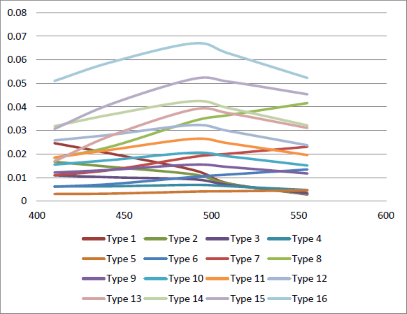 |
| INLAND | |
This type is intended for the use with rivers and lakes, but it also contains in situ coastal data as
input. The maximum number of clusters is 7. The clusters are not unique to any particular lake, region,
or a result of differences between freshwater and marine waters. Marine and freshwater stations can be
found in the same clusters. The OWTs show a pattern of increasing absorption in the blue/green for low
red/NIR features (classes 1 through 3), followed by increasing peak magnitude at 555 nm (classes 4
through 7). OWTs 1 through 5 show increasing chlorophyll-a concentrations, while OWTs 6 and 7 have lower
mean chlorophyll-a values. |
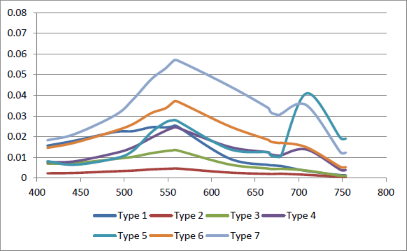 |
| GLASS_5C | |
This type is intended for the use with lakes and was developed in the frame of the EU-GLaSS project. The
in situ reflectance used to train the fuzzy classifier come exclusively from lake waters, which marks
the distance with the INLAND option. The water composition of the lakes has a higher mix and includes
many CDOM samples from Finnish lakes. Only 5 clusters are considered as the optimal number of classes.
The classes are sorted purely on remote sensing reflectance distribution and are representations of
optical conditions governed by the total absorption and scattering properties (IOPs). The wavelength
dependency gives clues for the interpretation: from chlorophyll_a absorbing dominant waters to higher
turbid waters due to the increase in the sediment load. |
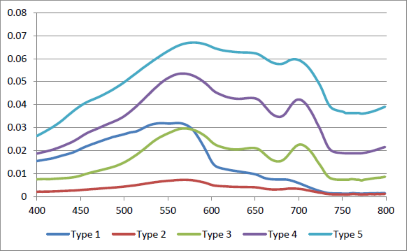 |
| GLASS_6C | |
This type is intended for the use with lakes and was developed in the frame of the EU-GLaSS project. The
in situ reflectance used to train the fuzzy classifier come exclusively from lake waters, which marks
the distance with the INLAND option. The water composition of the lakes has a higher mix and includes
many CDOM samples from Finnish lakes. Here 6 clusters are considered as the optimal number of classes.
The classes are sorted purely on remote sensing reflectance distribution and are representations of
optical conditions governed by the total absorption and scattering properties (IOPs). The wavelength
dependency gives clues for the interpretation: from chlorophyll_a absorbing dominant waters to higher
turbid waters due to the increase in the sediment load. |
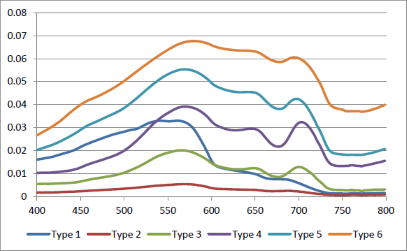 |
| GLASS_6C_NORMALISED | |
|
This type is intended for the use with lakes and was developed in the frame of the EU-GLaSS project.
Thein situ reflectance used to train the fuzzy classifier come exclusively from lake waters, which
marks the distance with the INLAND option. The water composition of the lakes has a higher mix and
includes many CDOM samples from Finnish lakes. Here 6 clusters are considered as the optimal number
of
classes.
The classes are sorted purely on remote sensing reflectance distribution and are representations of
optical conditions governed by the total absorption and scattering properties (IOPs). The wavelength
dependency gives clues for the interpretation: from chlorophyll_a absorbing dominant waters to
higher turbid waters due to the increase in the sediment load. The normalised classification shows
different results than the 6C because the reflectance values were normalised integrating the area
under the
curve.
This removes magnitude effects and focuses more on the spectral shape. |
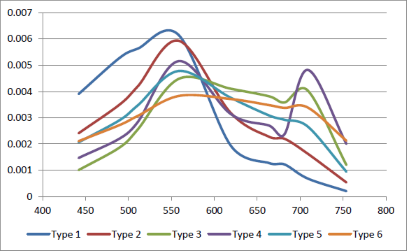 |
An Optical Classification Tool for Global Lake Waters
M. A. Eleveld, A. B. Ruescas , A. Hommersom , S. W. M. Peters and C. Brockmann
https://www.mdpi.com/2072-4292/9/5/420
A fuzzy logic classification scheme for selecting and blending ocean color algorithms
Moore, T. S., Campbell J. W., Feng, H. (2001)
IEEE Transactions on Geoscience and Remote Sensing 39(8): 1764-1776
An optical water type framework for selecting and blending retrievals from bio-optical algorithms in lakes
and coastal waters
Moore, T. S., Dowell, M. D., Bradt, S., Ruiz Verdu, A. (2014)
Remote Sensing of Environment
GLaSS Deliverable 3.3 2014 - Optical pre-classification method
Marieke A. Eleveld, Ana Ruescas, Annelies Hommersom (VU/VUmc, BC, WI)
https://step.esa.int/docs/extra/GLaSS-D3.3.pdf